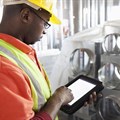Processing of raw materials for buildings and infrastructure developments and the actual construction processes are the industry's two largest contributors to greenhouse gas emissions. If it is to meet climate change mitigation targets by 2050, the construction industry will need to get serious about adopting more sustainable practices.

Peter Damhuis, vice-president, RIB CCS
RIB CCS vice-president, Peter Damhuis, identifies three important aspects that construction firms need to consider in pursuit of a greener construction process and more sustainable industry.
It starts with design
Damhuis says design is the most critical element in establishing the greenhouse gas (GHG) emissions for the lifetime (cradle to grave) of a construction project. “The design of a project affects the materials used as each material has a different carbon footprint that will affect the initial carbon calculations.
“In addition, the design can affect the lifecycle costing of a development, for example, what glass is used and how does it affect the heat absorption or retention of the building; should the structure be based on concrete or steel; and how would this impact heating in winter and cooling in summer?
“The efficiency of the design can materially impact the energy consumption during the lifetime of the project. So, does the ratio of glass to concrete affect the heating and cooling requirements; does the design include natural ventilation or evaporative cooling systems, which could result in lower energy requirements in the cooling system; does the glass or the roof design include solar generating capabilities; or does the water system allow for grey water consumption for toilets?”
Importantly, decisions made during the design phase do not merely affect the construction process, but the entire life cycle of the building or infrastructure project and can have a significant impact on emissions for decades to come.
Anna Hurlimann, Georgia Warren-Myers, Judy Bush 10 Nov 2022 Supply chain consideration
Damhuis notes that design is closely followed by supply chain as the second largest contributor to the carbon calculation. “Let’s consider concrete as an example: if the design calls for a concrete structure, then the project team needs to establish where it is sourcing its aggregates, what the haulage distance is – and determine how these two factors contribute to the carbon calculation.
“More importantly, project teams need to establish how to maximise efficiency in the mix design. There are many young technologists designing 'cement-free' concrete, which is set to make a vast difference to the carbon footprint of buildings and other infrastructure.”
He says a carbon analysis is applicable to most material, for example, recycled wood or glass. “Using recycled aggregates as part of your concrete or scraping roads to remove and recycle top layers for inclusion into a new asphalt layer are important supply chain considerations.”
Another aspect to consider is where the construction company sources its labour and how far its employees have to travel to get to site, as well as what vehicles they are using to get to site - buses, trains or individual cars – as these all have implications for a project’s carbon footprint.
Decarbonising the construction process
According to Damhuis, efficiency in construction to improve decarbonisation can be divided into three main areas of control: wastage, plant utilisation and planning.
“Once the supply chain has been maximised, wastage can be reduced by ensuring that no materials are procured beyond what is required and where waste is generated, it should be split and recycled.”
Plant utilisation considerations include factors such as using electric versus fuels. “Notably, the efficiency of the activity must be suited to the plant, and plant management must also be as efficient as possible,” adds Damhuis.
Underpinning this is good planning. Well planned and executed projects are less resource intensive and are more likely to be completed on time. Any additional resources and time taken to complete a project has a direct impact on the carbon usage during the construction phase.
Damhuis says the adoption of AEC-specific technology can help empower industry professionals to quantify, measure and track embodied carbon throughout the life of a project. “At the end of the day, if you can’t measure something, how can you reduce it? Technology is key to being able to do so.”
He says pursuing a sustainable future cannot be an academic exercise or rely on a few platitudes being bandied around a boardroom table. “As the call for more sustainable players grows louder, the sustainability of construction companies could be seriously impacted if they don’t pursue a decarbonisation agenda.”




























